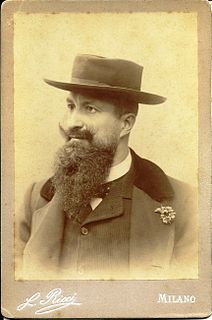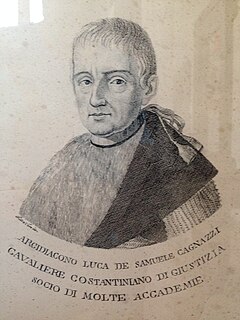
Count Adelardo Tommaso Salvadori Paleotti was an Italian zoologist and ornithologist.

Deroceras is a taxonomic genus of small to medium sized air-breathing land slugs in the family Agriolimacidae.

Deroceras panormitanum is a species of air-breathing land slug, a terrestrial pulmonate gastropod mollusc in the family Agriolimacidae. This article is about Deroceras panormitanumsensu stricto, which occurs predominantly only on Sicily and Malta. Previous to 2011, this name was also applied to what turned out to be a distinct species, Deroceras invadens, a species which has spread around the world and is often a pest. Because this is a recent change in the taxonomy, for information on the species commonly referred to in the literature before 2011 as Deroceras panormitanum, please see Deroceras invadens.

Teretia anceps is an extinct species of sea snail, a marine gastropod mollusk in the family Raphitomidae.

Tommaso di Maria Allery, marchese di Monterosato was an Italian malacologist.

Limax dacampi is a species of air-breathing land slug, a terrestrial pulmonate gastropod mollusk in the family Limacidae, the keelback slugs.

Deroceras invadens is a species of air-breathing land slug, a terrestrial pulmonate gastropod mollusc in the family Agriolimacidae. Until 2011, this widely distributed species was known as Deroceras panormitanum, and earlier as Deroceras caruanae or Agriolimax caruanae, but Reise et al. (2011) showed that these names refer to a distinct species of similar external appearance known at that time only from Sicily and Malta. Consequently, although the more widespread species was already well known, it then had to be redescribed under the new name of D. invadens. Genetic evidence has indicated that D. invadens is native in southern Italy, including parts of Sicily, and possibly parts of central Italy. Elsewhere it has been introduced, predominantly within the last 100 years, but its spread has been constrained by cold winter temperatures.
Emilio Berio was an Italian entomologist and lawyer.

Carlo Pollonera was an Italian painter, particularly of landscapes, and also an important malacologist.
Limax doriae, common name Doria's slug, is a species of air-breathing land slug, a terrestrial pulmonate gastropod mollusk in the family Limacidae, the keelback slugs.

Ariunculus is a genus of air-breathing land slugs in the family Arionidae, the roundback slugs. Sometimes it has been considered as a subgenus of Arion, and sometimes the subgenus Ichnusarion has been raised to generic rank.

Mario Lessona was an Italian zoologist and malacologist. He was the son of the prominent natural scientist and senator Michele Lessona and his wife Adele Masi Lessona, who was very much involved in her husband's work, particularly in making translations. A son of Adele Lessona by an earlier marriage was the painter and malacologist Carlo Pollonera, with whom Mario published a monograph on Italian slugs. Mario also coauthored various scientific works with his brother-in-law, the zoologist and senator Lorenzo Camerano.
This bibliography lists publications authored by the Italian malacologist and painter Carlo Pollonera (1849-1923). The article endeavours to be comprehensive, and includes all works listed in previous bibliographies of Pollonera. Zoological Record and AnimalBase have also been utilised. Works listed without an internet link have generally not been examined directly. Dates given here follow those printed on the individual issue wrappers, which sometimes differ from those on the title page of the volume.

Ambigolimax is a genus of air-breathing land slugs in the family Limacidae, the keelback slugs.

Luigi Robecchi Bricchetti was an Italian explorer, geographer, cartographer and naturalist.
Raffaello Bellini (1874-1930) was an Italian zoologist who specialised in mollusca.
Giuseppe Nobili was an Italian zoologist at the University of Turin, specialising in Crustacea, who was born at Omegna in Piedmont in 1877 and died at Omegna in 1908. His father was Dr. Gaudenzio Nobili and his mother, Adele Antonioli Nobili.
Bela pseudoappeliusi is an extinct species of sea snail, a marine gastropod mollusk in the family Mangeliidae.

Luca de Samuele Cagnazzi was an Italian archdeacon, scientist, mathematician, political economist. He also wrote a book about pedagogy and invented the tonograph.
Teretia elegantissima is an extinct species of sea snail, a marine gastropod mollusk in the family Raphitomidae.















